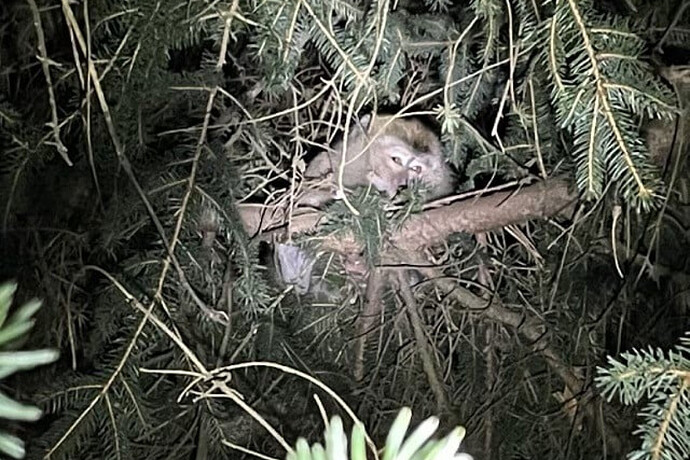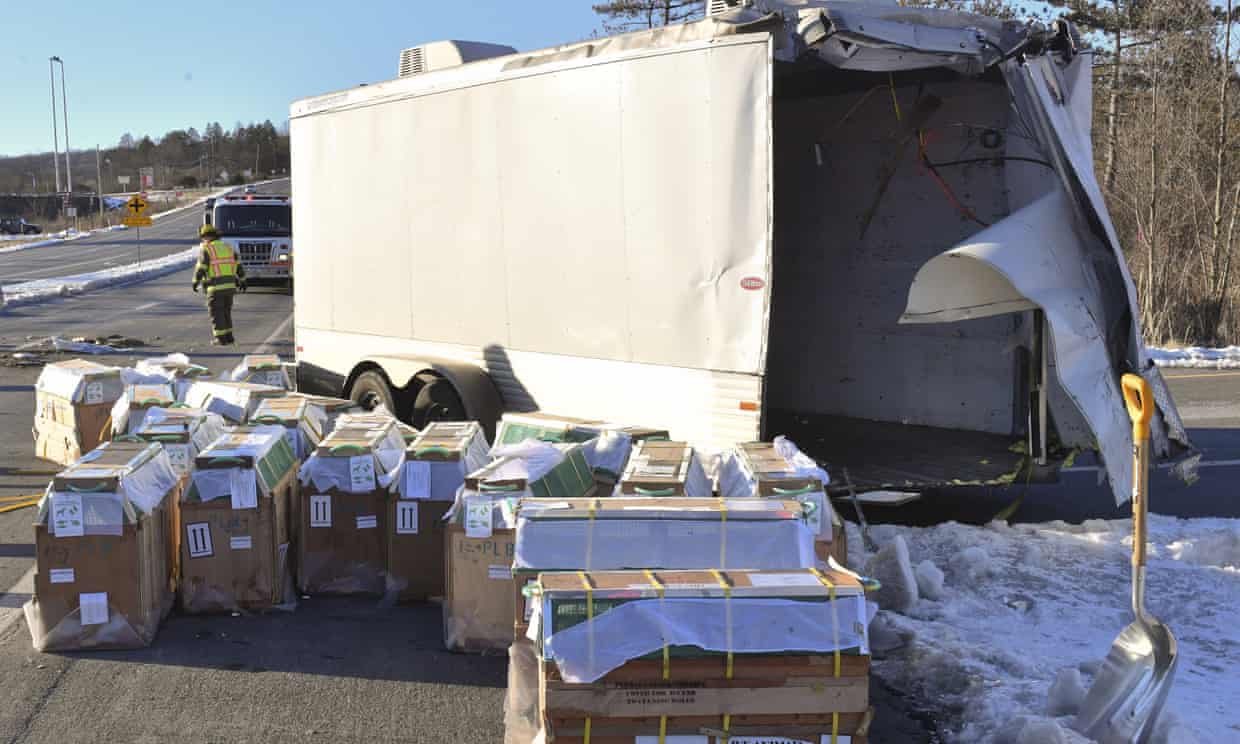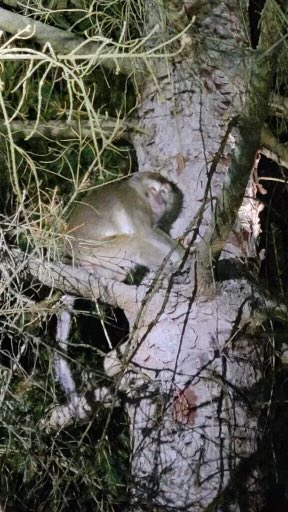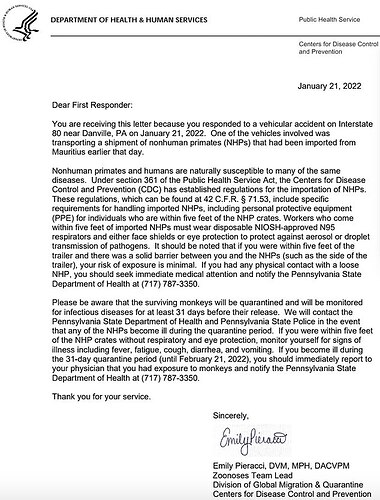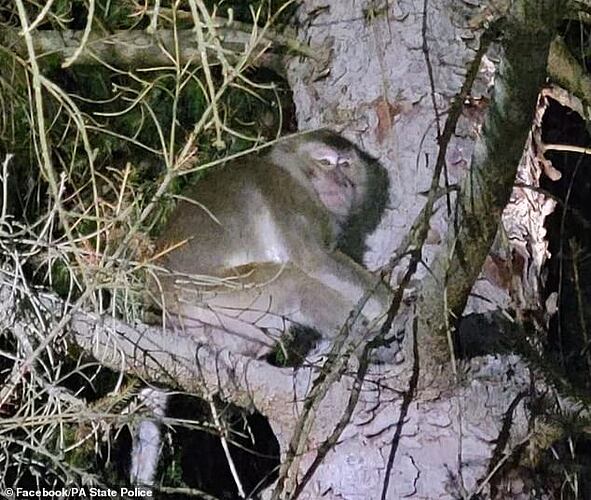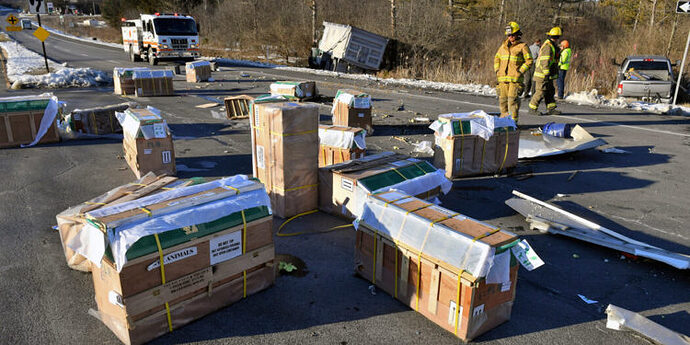PA State Police report
Thank you! Much appreciated.
Monkeys Loosed in Pennsylvania Truck Crash were DISEASED; Being Brought to CDC-Approved Quarantine
NATION NEWSDESK 23 JANUARY 2022 HITS: 8085
A truck crash in Pennsylvania last week made new when some of its cargo - Monkeys - got loose after the crash. Now we find out the monkeys were DISEASED, and being brought to a CDC-approved Quarantine facility when they got loose.
The last of the escaped monkeys from the crash of a truck towing a trailer load of 100 of the animals was accounted for by late Saturday, a day after the pickup collided with a dump truck on a Pennsylvania highway, authorities said.
The map below shows the County and Rt. 80:
Several monkeys had escaped following Friday’s collision, Pennsylvania State Police said. But only one had remained unaccounted for as of Saturday morning, prompting the Pennsylvania Game Commission and other agencies to launch a search for it amid frigid weather.
Kristen Nordlund, a spokesperson with the Centers for Disease Control and Prevention, said in an email Saturday evening that all 100 of the cynomolgus macaque monkeys had since been accounted for. Three were dead after being euthanized.
The email did not elaborate on why the three were euthanized or how all came to be accounted for. But Nordlund said those euthanized were done so humanely according to American Veterinary Medical Association guidelines.
The shipment of monkeys was en route to a CDC-approved quarantine facility after arriving Friday morning at New York’s Kennedy Airport from Mauritius, an Indian Ocean island nation, police said. The Atlanta-based CDC said the agency was providing “technical assistance” to state police in Pennsylvania.
The collision occurred Friday on a state highway near an Interstate 80 exit in Pennsylvania’s Montour County, Trooper Andrea Pelachick told The Daily Item newspaper of Sunbury.
The location of the quarantine facility and the type of research for which the monkeys were apparently destined weren’t clear, but cynomolgus monkeys are often used in medical studies. A 2015 paper posted on the website of the National Center for Biotechnology Information referred to them as the most widely used primate in preclinical toxicology studies.
Hal Turner Commentary
So now what? What other animals did those monkeys interact with while they were loose? What disease(s) were they being Quarantined for and what did they spread while they were out?
Is this the start of a new outbreak of yet ANOTHER disease the world will have to battle? Didn’t they make a horror move “12 monkeys” about a similar thing?
If you start to hear about an outbreak of some new disease in Pennsylvania that has scientists and Doctors “baffled” you’ll know where it came from. What none of us know - yet - is what diseases these monkeys had that they were going to Quarantine. God help us all if it was something like Ebola.
From police report, not sure monkey loose truly occurred.
I hope it was people in biohazard suites!!!

CDC Is Monitoring Local Residents for Cold-like Symptoms Following Crash of Semi Carrying 100 CDC Test Monkeys
By Jim Hoft
Published January 23, 2022 at 8:46pm
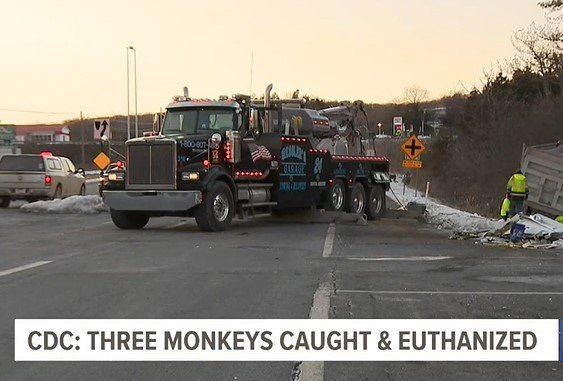
A truck and trailer carrying about 100 monkeys collided with a dump truck Friday afternoon along Route 54 just off Interstate 80 near Danville, Pennsylvania.
Three monkeys escaped the crash. The monkeys were later reportedly “humanely euthanized.”
The CDC is now monitoring local residents for cold-like symptoms.
That’s very comforting considering the lab leak from Wuhan that just destroyed the global economy.
The monkeys are originally from Mauritius off the African coast.
WNEP reported:
According to a CDC spokesperson, the monkeys were en route to a CDC-approved quarantine facility after landing Friday morning in New York. They are originally from Mauritius, a country in eastern Africa.
The crash happened around 3:30 p.m. Friday afternoon, that’s when the three monkeys got free in the Danville area.
Police say the driver who was transporting the monkeys was charged in the crash.
Originally, state police told us four monkeys were on the loose.
As of Saturday afternoon, some people were still worried.
“Little monkeys, we got bears, we have coyotes, we have deer, you know all the time. A little 3-pound monkey doesn’t scare me, but why are they so concerned about it is what concerns me,” said Howie Lerch, Valley Township.
Friday night Newswatch 16 spoke with Michelle Fallon of Danville, who saw the entire accident. She jumped into action; helping both drivers and the loads they were carrying.
“I walk up back on the hill and this guy tells me, ‘Oh, he’s hauling cats. I said, ‘oh.’ So I go over to look in the crate and there’s this green cloth over it. So I peel it back, I stick my finger in there and go ‘kitty, kitty.’ It pops its head up and it’s a monkey,” Fallon said.
Fallon was contacted Saturday by the CDC and was told to monitor herself for any cold-like symptoms.
Thanks Colonel. We all kind of knew this was coming. Downright predictable.
Driver who stopped to help when truck carrying 100 lab monkeys crashed in Pennsylvania and put her hand in one of the cages says she now has a cough and pink eye after one of the macaques HISSED in her face
- Woman who stopped to help monkeys in truck crash is now feeling unwell
- Michelle Fallon, from Danville near Scranton, was directly behind the truck
- Fallon said the day following the accident she developed a cough and pink-eye
- She has begun a course of antiviral drugs and treatment to prevent rabies
- The last of the four escaped monkeys was accounted for by late Saturday
- One of the cynomolgus macaques, which are also known as crab-eating or long-tailed macaques, was found in a tree
- Pennsylvania residents had been warned not to engage a crab-eating macaque that escaped from a truck carrying 100 of them to a lab
- Crates with live monkeys inside were strewn across State Route 54 in Danville, 130 miles from Philadelphia, after the crash
- A witness said he thought he saw a cat run across the road before making the shocking realization that it was actually a fleeing primate
By JAMES GORDON FOR DAILYMAIL.COM
PUBLISHED: 02:33 EST, 25 January 2022 | UPDATED: 08:59 EST, 25 January 2022
2.9k shares
A woman who stopped to help after a truck carrying 100 lab monkeys crashed in Pennsylvania fears she’s caught an illness after one of the macaques hissed in her face, leaving her with pink eye symptoms.
Michelle Fallon, from Danville near Scranton, was driving directly behind the vehicle when it crashed, throwing animal crates all over the highway and smashing some to pieces. Three of the macaques escaped and went on the run, but all have since been captured and humanely euthanized. All of the other monkeys - who’d arrived in the US from Mauritius that morning, and were en route to a lab, have been accounted for.
Fallon has now had a rabies shot, and wrote about the symptoms she has since suffered on Facebook - and also told PA Homepage that she’d developed symptoms of pink eye - an inflammation or infection of the eye ball.
She said: 'I was close to the monkeys, I touched the crates, I walked through their feces so I was very close. So I called (a helpline) to inquire, you know, was I safe?
‘Because the monkey did hiss at me and there were feces around, and I did have an open cut, they just want to be precautious.’
Fallon said she got out to help both the driver and the animals in their cages, initially believing them to be cats. When she approached and put her hand on the cage, she says the monkey hissed at her.
The day following the accident, Fallon suddenly developed a cough and pink eye, which became so bad that she had to visit the emergency room at Geisinger Medical Center in Danville.
+12
View gallery
Michele Fallon, who was exposed to the monkeys on Friday after the crash said she is experiencing some side effects in her eye and has begun a course of preventative rabies treatment
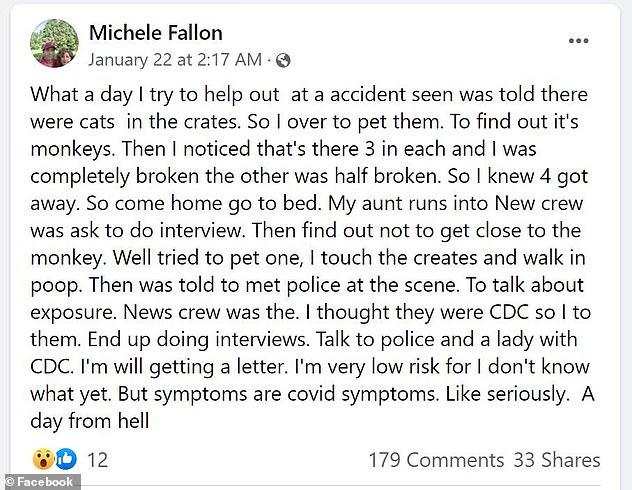
+12
View gallery
Fallon wrote of her experience on her Facebook page
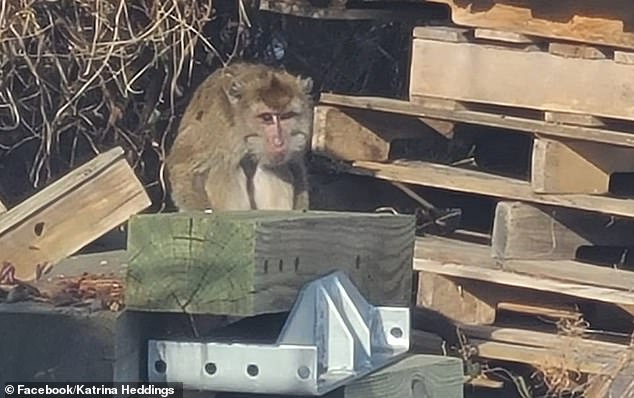
+12
View gallery
Pictured: the last of the four monkeys to be captured after the trailer they were in crashed into a dump truck on a Pennsylvania highway on Friday
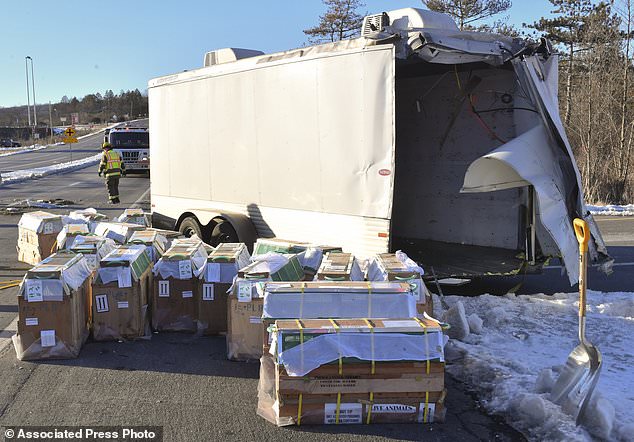
+12
View gallery
Crates holding live monkeys are collected next to the trailer they were being transported in along state Route 54 at the intersection with Interstate 80 near Danville, Pennsylvania on Friday after a pickup pulling the trailer carrying the monkeys was hit by a dump truck
Truck transporting 100 monkeys to a lab crashes in Pennsylvania
Loaded: 0%
Progress: 0%
0:00
Previous
Play
Skip
Mute
Current Time0:00
/
Duration Time1:28
Fullscreen
Need Text
What is the monkey Herpes B virus
Contracting the B virus is extremely rare, but it can lead to severe brain damage or death if you do not get treatment immediately.
People typically get infected with B virus if they are bitten or scratched by an infected macaque monkey, or have contact with the monkey’s eyes, nose, or mouth.
You may develop small blisters in the wound or area on your body that had contact with the monkey.
There are no known vaccines to protect against a B virus infection, and so people are urged not to touch or feed monkeys.
Only one case has been documented of an infected person spreading B virus to another person.
Source: CDC
Infectious disease doctors gave her the first of four rabies injections together with some anti-viral drugs.
She said on Facebook that she was monitoring for symptoms of rabies and monkey herpes virus B.
‘What a day! I tried to help out at an accident and was told there were cats in the crates. So I went over to pet them only to find out it’s monkeys. Then I noticed that there was three in each, with some completely broken, so I knew four had got away,’ Fallon wrote of her experience on her Facebook page.
‘I came home to go to bed and my aunt ran into a news crew and she found out not to get too close to the monkey. Well, I tried to pet one. I touched the crates and walked in poop. I was told meet the police at the scene to talk about exposure’, she explained.
‘I spoke with the police and a woman from the CDC I am getting a letter and I’m very low risk for I don’t know what yet. But my symptoms are covid symptoms. Like seriously. A day from hell!’
Fallon has been told to keep a close eye on her health for the next month in case she develops any infectious disease as a result of being so close to them.
The test monkeys were on their way to a laboratory in Florida when the truck crashed into a garbage truck.
Fallon said that she spoke with the pickup driver and a passenger directly after the crash.
The driver appeared to be disoriented, and the passenger thought he might have injured his legs, she said.
The pickup was heading west on I-80 when it got off at the Danville exit and then immediately tried to get back on, driving across the other lane.
RELATED ARTICLES
-
 Can Japan’s Monkey Queen have it all? Yakei violently…
Can Japan’s Monkey Queen have it all? Yakei violently… James-Webb reaches its deep-space parking spot ONE MILLION…
James-Webb reaches its deep-space parking spot ONE MILLION…
SHARE THIS ARTICLE
Share
Fallon explained how she was behind the pickup when it was hit on the passenger side by the dump truck, tearing off the front panel of the trailer and sending more than a dozen crates tumbling out.
She and another motorist who stopped to help were standing near the scene when the other driver said he thought he saw a cat run across the road, Fallon said.
+12
View gallery
The CDC has now written to Fallon informing her to watch for any further symptoms in the next month
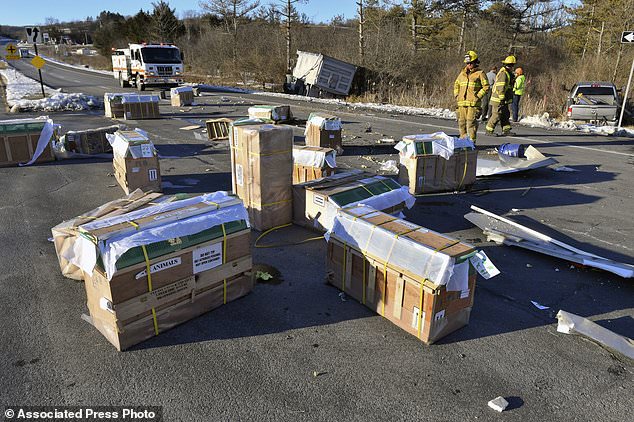
+12
View gallery
Crates holding live monkeys are pictured scattered across the westbound lanes of state Route 54 on Friday at the junction with Interstate 80 near Danville, Pennsylvania
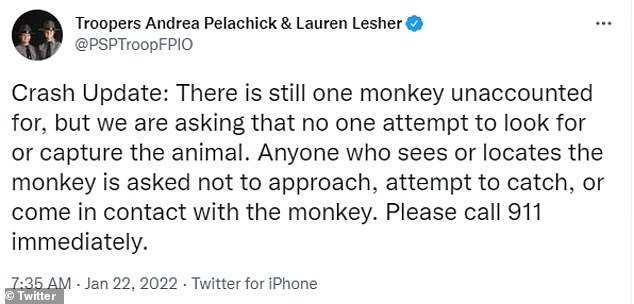
+12
View gallery
State police had urged people not to look for or capture the crab-eating macaque monkey following the crash on a a highway in Danville, about 130 miles from Philadelphia
Fallon peeked into a crate and saw a small monkey looking back at her, she told the newspaper.
‘They’re monkeys,’ she told the other motorist.
Jamie Labar, who was working the front desk of a nearby Super 8, said she initially thought it was a joke when someone told her of the accident.
All of the escaped monkeys were accounted for by Saturday after the Pennsylvania Game Commission and other agencies launched a search for it, amid frigid weather.
Three of the escaped lab monkeys were dead after being euthanized.
One of the cynomolgus macaques, which are also known as crab-eating or long-tailed macaques, was found in a tree, and three shots were later heard, WNEP reported.
State police had urged people not to look for or capture the cynomolgus macaque monkey following the crash on a State Route 54 near an Interstate 80 exit in Danville, about 130 miles from Philadelphia.
+12
View gallery
One of the monkeys (pictured) was found in a tree, and three shots were later heard, WNEP reported

+12
View gallery
PETA reminded residents after the crash that ‘there is no way to ensure that monkeys are virus-free.’ Pictured, one of the monkeys was found hiding in a tree
‘Anyone who sees or locates the monkey is asked not to approach, attempt to catch, or come in contact with the monkey. Please call 911 immediately,’ troopers had tweeted prior to locating the primates.
Trooper Lauren Lesher had said the concern was ‘due to it not being a domesticated animal and them being in an unknown territory. It is hard to say how they would react to a human approaching them.’
The shipment of monkeys was en route to a CDC-approved quarantine facility after arriving Friday morning at New York’s Kennedy Airport from Mauritius, the agency said.
Crates littered the road Friday as troopers searched for the monkeys, rifles in hand.
Meanwhile, Valley Township firefighters used thermal imaging to locate the animals, with a also assisting the recover effort.
The US Centers for Disease Control and Prevention (CDC) said the agency provided ‘technical assistance’ to state police.
The truck had been on its way to a lab at the time of the crash.
The location of the lab and the type of research for which the monkeys were destined weren’t clear, but the cynomolgus monkeys are often used in medical studies.

+12
View gallery
The Pennsylvania Game Commission and other agencies used a helicopter to search for it amid frigid weather
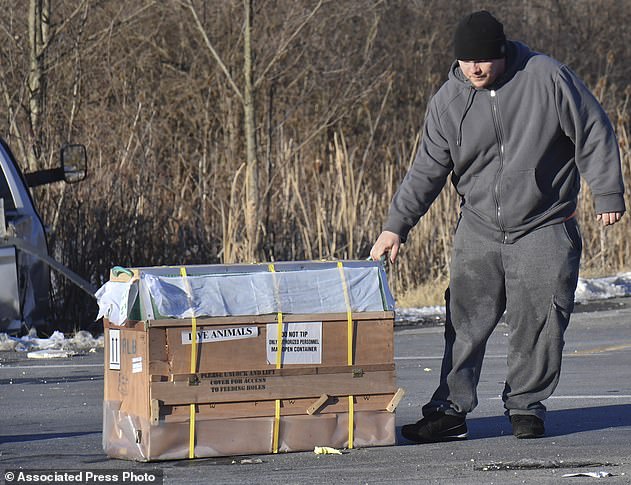
+12
View gallery
Crates littered the road Friday as troopers searched for monkeys, rifles in hand. Valley Township firefighters used thermal imaging to locate the animals, and a helicopter assisted
A 2015 paper posted on the website of the National Center for Biotechnology Information referred to them as the most widely used primate in preclinical toxicology studies.
Lesher said state police secured the scene for the Pennsylvania Department of Health and the U.S. Centers for Disease Control and Prevention.
Although macaque monkeys are cute, PETA reminded residents after the crash that ‘there is no way to ensure that monkeys are virus-free,’ noting that ‘records show that monkeys in laboratories in the US have been found with tuberculosis, Chagas disease, cholera and MRSA.’
The monkey isn’t just dangerous, it’s expensive - crab-eating macaques can cost up to $10,000, according to The New York Times.
The monkeys, whose DNA is similar to that of humans, have been in high demand amid the COVID-19 pandemic, with some scientists calling for an emergency reserve of the test subjects similar to the country’s stockpiles of oil and grain.
Those who believe they may have had contact with the monkeys are asked, per the CDC letter, to seek medical attention and contact Pennsylvania Department of Health at (717) 787-3350.
ADVERTISEMENT
Read more:
- UPDATE: Only one monkey still unaccounted for after crash | wnep.com
- Monkeys Escape After Truck Crashes on Pennsylvania Highway - The New York Times
- Preventing Herpes B Virus Infection | CDC
- Troopers Andrea Pelachick & Lauren Lesher on Twitter: “Crash Update: All monkeys have been accounted for.”
- www.pahomepage.c…
Check out where “12 monkeys” was filmed
Just down the road from where the new batch of monkeys got loose!!! Coincidence???
Moar fear BS. Guess you believe it.
Also have some (interests) in the area!
Questions Remain After Highway Crash Involving Monkeys
in News
Share on FacebookShare on Twitter
In the 11 days since a truck hauling 100 monkeys from Mauritius crashed in Pennsylvania, one woman who got close to the scattered crates of monkeys on the highway has been treated for possible symptoms of illness.
And Kenya Airways, which is believed to have transported the monkeys to the United States, has decided not to renew its expiring contract to ship research primates here.
ADVERTISEMENT
No other reports of possible illness related to the crash have emerged, according to state and federal health officials, who said it was not known whether the Pennsylvania woman’s symptoms were related to the cynomolgus macaques, which were being quarantined and monitored for diseases.
Experts said that direct exposure to monkey saliva or feces could be dangerous, but that the risk of a broader outbreak was low.
The woman, Michele Fallon, 45, of Danville, Pa., said on Tuesday that she had been given two doses of the rabies vaccine, antiviral medication and antibiotic eye drops after she had a runny nose, a cough and filmy buildup and crust in her eye. She also vomited over the weekend, she said, possibly because of the antiviral medication.
She said her eye was much improved and that she was “feeling better,” though she still felt “queasy.”
She said she was awaiting the results of a blood test for monkey-borne diseases and was grateful for advice she had been receiving from Dr. Lisa Jones-Engel, a primate scientist who works with People for the Ethical Treatment of Animals, which has long opposed primate research and has asked two federal agencies to investigate the crash.
ADVERTISEMENT
Ms. Fallon said she was driving home on Jan. 21 in Montour County, about 150 miles northwest of Philadelphia, when she saw the crash, in which a dump truck hit a pickup truck that was hauling a trailer with the macaques. The monkeys had arrived at Kennedy International Airport in New York and were on their way to a quarantine facility.
Ms. Fallon stopped to see if anyone was hurt and found crates strewn across the roadway.
Told by a bystander that cats might be inside, she stuck her finger in one and saw brown fur. When the animal made a “weird noise,” she put her face closer to get a better look. That’s when, she said, she noticed that it wasn’t a cat but a monkey, which “hissed” at her. She said she felt a mist.
She also stepped in monkey feces, she said.
That night, she went to a party with people who later tested positive for the coronavirus, she said. Ms. Fallon said that while she herself had tested negative, the series of events added up to “the worst day of my life.”
Three of the monkeys escaped after the crash, but were quickly found and “humanely euthanized,” the Centers for Disease Control and Prevention said, without offering further details.
The C.D.C. referred questions about Ms. Fallon’s condition to the Pennsylvania Department of Health and her doctor, saying it does “not provide clinical care for individuals.”
Barry Ciccocioppo, a spokesman for the Department of Health, said in an email: “It is not known if that individual’s medical condition is related.”
“We take any report of exposure to these nonhuman primates very seriously,” Mr. Ciccocioppo said. “The Department of Health recommends that anyone who thinks they may have been exposed to a nonhuman primate to contact their health care provider.” The doctor can then consult with the department about the risks and best course of treatment, he said.
Ms. Fallon’s doctor’s office referred questions to the Geisinger health system, which did not immediately respond to an email and phone call.
In a letter issued to the authorities after the crash, the C.D.C. said that anyone who was within five feet of the monkeys’ crates without respiratory and eye protection should monitor themselves for signs of illness such as fever, fatigue, cough, diarrhea and vomiting.
The letter noted that monkeys and humans are naturally susceptible to many of the same diseases. It said the surviving monkeys would be quarantined and monitored for infectious diseases for at least 31 days.
Mr. Ciccocioppo described the letter as “precautionary and a form letter used in such incidents.”
Michael L. Kull, the chief of the Valley Township Fire Department, said that he and other emergency personnel who responded to the crash did not get close enough to the monkeys to risk any kind of infection.
“Out of an abundance of caution, we will be careful,” he said, but added that he was unconcerned. “I have lost no sleep.”
Dr. Christine Petersen, director of the Center for Emerging Infectious Diseases at the University of Iowa, said serious diseases like monkey pox and Ebola are rare in cynomolgus macaques, but that “precaution should be taken” by anyone who may have come into contact with one.
“A cornered monkey is not the kindest of creatures,” she said. “If they did get bitten or spit on, that’s worrisome.”
“But what are the odds that any three random monkeys could somehow spread something dastardly to a first responder?” Dr. Petersen added. “It’s not high.”
Dr. Suresh V. Kuchipudi, a clinical professor in the department of veterinary and biomedical sciences at Pennsylvania State University, said that so long as someone who has been too close to a wild animal like a macaque is receiving treatment for any infection, the risk of it spreading to other people is low.
Public health concerns were not the only fallout from the crash.
After PETA contacted Kenya Airways, the company said last week that it would not renew its contract for the transportation of macaques when it expires this month. In doing so, it joined several airlines, including major American carriers, that have refused to transport animals used in medical research.
PETA claimed victory in a news release. It has also asked the U.S. Department of Agriculture and the U.S. Department of Transportation to investigate the crash, warning of a dangerous lack of oversight for the transportation of primates.
“U.S. laboratories haven’t been able to prevent tuberculosis, cholera, campylobacteriosis, Chagas’ disease or other deadly pathogens from infecting the monkeys they cage and experiment on,” Dr. Jones-Engel said in a statement, “and they still put these monkeys on trucks that travel our highways nationwide.”
The post Questions Remain After Highway Crash Involving Monkeys appeared first on New York Times.


